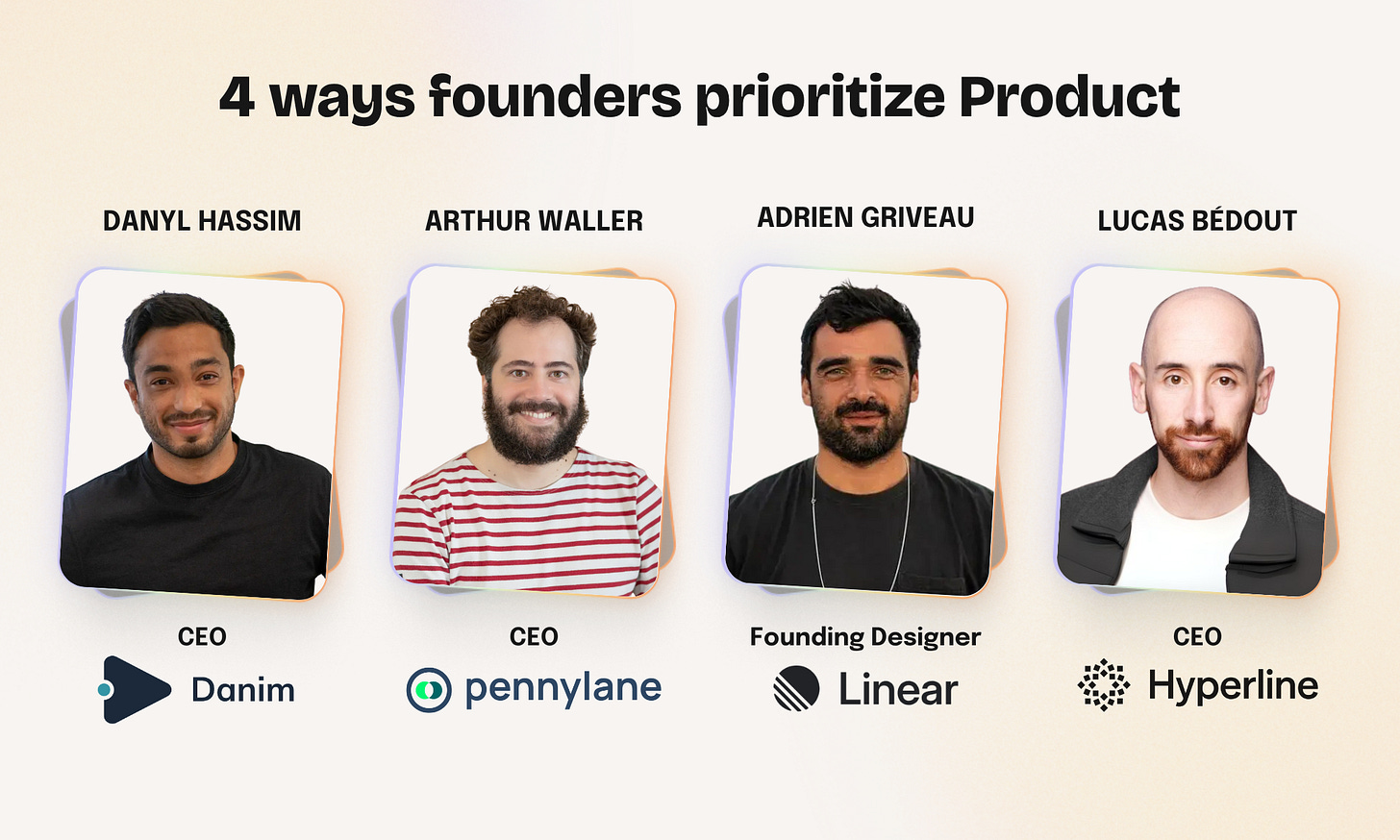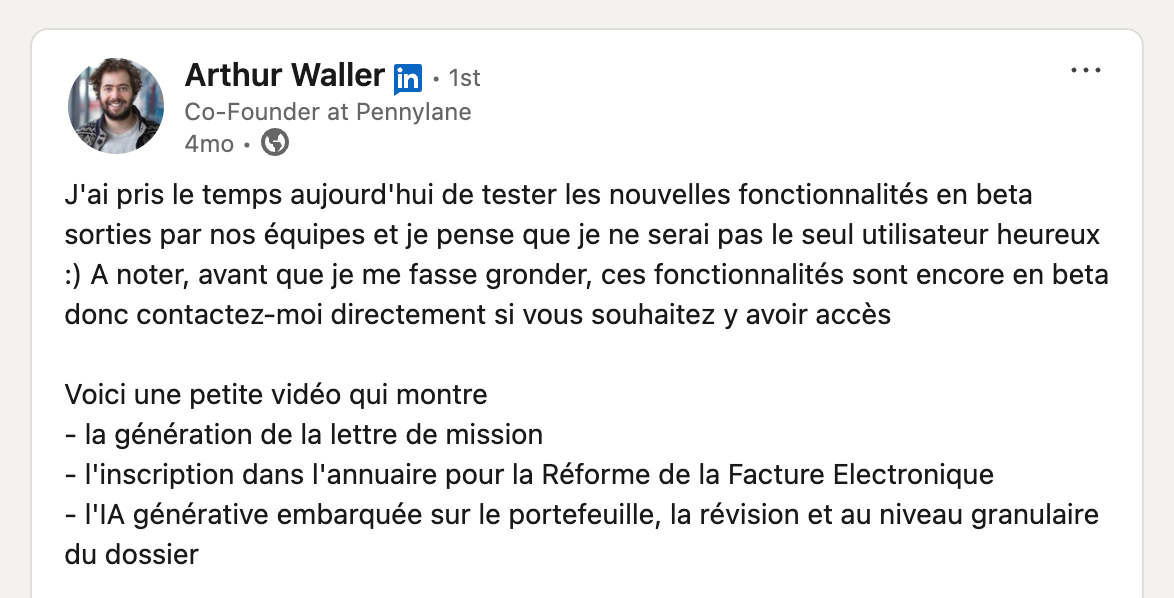How to prioritize Product with 4 proven methods
By 4 the CEOs and Product Leaders from Linear, Pennylane, Danim and Hyperline
Hey, I’m Timothe, cofounder of Stellar & based in Paris.
I’ve spent the past years helping 500+ startups in Europe build better product orgs and strategies. Now I’m sharing what I’ve learned (and keep learning) in How They Build. For more: My Youtube Channel (🇫🇷) | My Podcast (🇫🇷) | Follow me on Linkedin.
If you’re not a subscriber, here’s what you’ve been missing:
In this post, I share my perspective on one of the hardest questions in product management: how do you decide what to build next?
Instead of following a rigid playbook, the best Product teams I’ve met apply a mix of frameworks, fast experiments, and strategic discipline. To illustrate this, I’ve brought together insights from different founders and product leaders I’ve interviewed.
In this newsletter, I break down 4 proven methods of product prioritization, each supported with concrete examples from the field.
Big thanks to Arthur Waller (Pennylane), Lucas Bédout (Hyperline), Adrien Griveau (Linear) and Danyl Hassim (Danim) for their insights in this edition.
Disclaimer: The organizational choices and technical solutions shared in this newsletter aren’t meant to be copied and pasted as-is. Always keep your company’s context in mind before adopting something that works elsewhere! 😊1. Let user signals guide your roadmap
One of the clearest ways to prioritize is to follow the strongest signals from your users. When dozens of customers start asking for the same thing, that’s not noise. It’s a business opportunity.
Arthur Waller, CEO of Pennylane, explained how he tested 3 different AI-powered features in a Linkedin post. One of them, helping accountants generate engagement letters, received overwhelming interest:
“I had 60 accountants immediately asking to join the beta for engagement letters, and almost no one for the other two features.” - Arthur Waller (CEO of Pennylane)
That single signal was enough to prioritize the feature, even though it wasn’t core to their original product vision.
The lesson is simple: watch closely what customers actually respond to, not just what you think will be valuable. Product teams often fall into endless debates about what matters most. Instead, let the intensity of customer reactions guide your calls.
But you need a system to collect and compare these signals. That means tracking inbound feature requests, monitoring responses to changelogs, and running lightweight polls or experiments. Over time, the patterns become obvious, and you’ll know which ideas deserve immediate attention.
2. Prototype fast and test in the wild
Another powerful method is to move quickly from idea to prototype and put it in front of users. The goal isn’t to build the perfect feature. It’s to validate whether the need is real.
Lucas Bédout (Hyperline’s CEO) shared how his team often inserts fake options in the product menu, known as “contactos,” to measure demand before building. When users click on these grayed-out items, the team instantly knows there’s appetite. If 5 customers request the same integration in a single week, they build it right away.
Adrien Griveau, who worked at Linear, reinforced the same point:
“We prototyped constantly, sometimes even just a design in Figma, and tested live with users. 90% of my design work went to the trash, but it was worth it to find the 10% that created real wow moments.” — Adrien Griveau (Linear’s founding Designer and 3rd employee)
The speed of prototyping is key. Instead of debating hypotheticals internally, you generate evidence in days by shipping a small test. That could be a clickable mockup, a hidden feature toggle, or even deliberately “breaking” a non-critical flow to see who complains.
When teams adopt this mindset, prioritization becomes less about guessing and more about observing real usage patterns. You don’t need to be right all the time—you just need to test often enough that the winners emerge naturally.
Stay anchored to your product vision
Prioritization isn’t only about demand. Sometimes, what users ask for conflicts with your vision for the product. In those moments, discipline matters more than flexibility.
Danyl Hassim (Danim’s CEO) explained this while building a SaaS tool for real estate agents. His team experimented with an “advanced mode” that gave power users more customization options. But it turned out only 5% of customers wanted it, and the extra complexity risked confusing the other 90%.
“We killed features we personally loved because they didn’t align with our promise of keeping the product simple and intuitive.” — Danyl Hassim (Danim’s CEO)
This is where the Product vision becomes your North star. If your brand stands for speed and simplicity, you can’t prioritize features that make the workflow slower, even if a vocal minority demands them. Similarly, if your mission is to serve a specific persona, you can’t let a single big customer hijack your roadmap with niche requests.
The test is straightforward: does this new feature reinforce your product’s identity, or does it pull you away from it? If it’s the latter, it’s often better to say no—even at the cost of losing a few customers.
Align prioritization with business strategy
Finally, product prioritization must align with the broader business strategy. No framework will help if you’re optimizing for the wrong customers.
At Pennylane, the Exco defines 3 top priorities every quarter:
Accountants
Small businesses
Mid-market clients.
Features are then judged by how much they advance these strategic goals. Everything else gets deprioritized, no matter how appealing it may sound.
As Arthur Waller put it, the company doesn’t rely on RICE or weighted scoring at the executive level.
“Our prioritization is mostly discussion-driven, anchored in clear business priorities.” — (Arthur Waller’s CEO)
That doesn’t mean frameworks don’t matter. They’re often used within product squads but the ultimate alignment comes from the company’s North star metrics and customer segments.
For founders and Product leaders, this is the most important reminder: product decisions are business decisions. If your company strategy shifts, your roadmap must follow. Without this alignment, you risk building technically impressive features that don’t move the business forward.
Avoid the trap of overbuilding
One of the most common mistakes in prioritization is overbuilding. Teams get pulled in by feature requests from large clients, or by the temptation to compete on feature count. The result is a bloated, fragile product that serves no one well.
Lucas Bédout (Hyperline’s CEO) described this with a vivid metaphor: his product roadmap started looking like a “weeping willow,” with countless branches growing in different directions to satisfy unique client requests.
Each new feature seemed harmless on its own, but together they created complexity and technical debt. The turning point was realizing that not every request should be fulfilled inside the core product. Sometimes, customers must build on top of your platform instead.
Adrien Griveau (Linear’s Founding Designer) also emphasized that most design work gets thrown away. That’s not waste, it’s discipline. If you don’t say ‘no’ often enough, your product becomes cluttered. The courage to discard 90% of ideas is what keeps the remaining 10% sharp and impactful.
The actionable lesson: prioritize by subtraction as much as by addition. Regularly ask what can be removed or simplified. A lean, focused product is easier to use, easier to sell, and easier to maintain than a feature-stuffed one.
Strong user signals are the most reliable way to cut through internal debates and identify real priorities.
Lightweight prototypes and fake doors allow you to test demand before committing development resources.
Vision alignment prevents feature creep and protects your product from being hijacked by niche requests.
Business strategy should anchor product prioritization, ensuring that features drive company-level outcomes.
Most design work should be discarded—the discipline of saying no is as important as building.
Overbuilding leads to fragile products; simplifying often delivers more value than adding.
Prioritization is a constant negotiation between what users want and what your product stands for.
Big customers can distort your roadmap—filter their requests through the lens of scalability.
Speed matters: the faster you test, the faster you uncover which ideas truly matter.
Customer adoption is a better success metric than internal excitement about a feature.
Minimalism is powerful: features that are universally adopted drive more growth than advanced customizations.
Executive-level prioritization should be anchored in business goals, not just product frameworks.
Letting go of features you love is often necessary to keep the product simple.
Testing demand through small experiments reduces risk and saves development time.
Prioritization is not about being right every time—it’s about running enough bets to find the winners.
My video (in french 🇫🇷) about product prioritization
If you enjoyed this edition of How They Build, I took a deeper, unfiltered dive into the topic in my latest YouTube video. For now, this new raw video format is only available in French — but let me know if you’d like to see it in English.
If you enjoyed this edition of How They Build, I dive deeper in my latest YouTube video (currently in French).
Also available as a podcast (French for now):
Enjoyed this newsletter? Share it with your network using the button below—your support means a lot!




